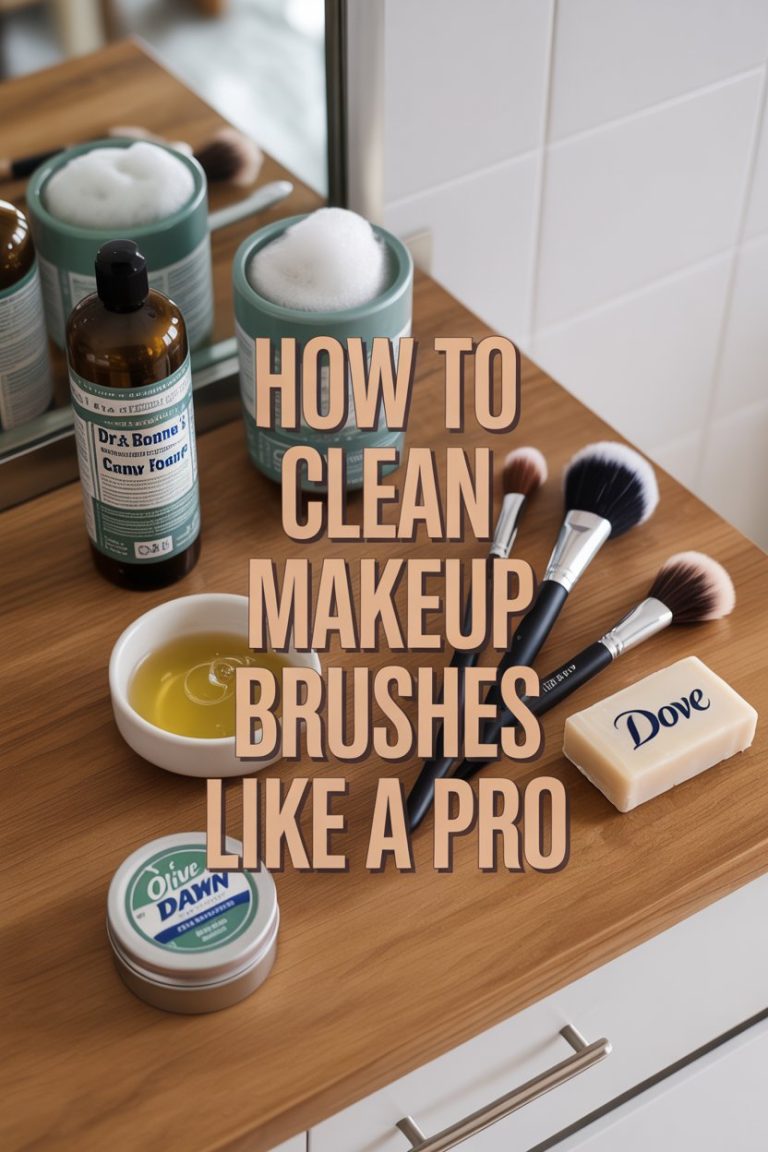Keeping a bathroom spotless can feel like a never-ending chore. Between soap scum, limescale, and general grime, it’s easy to reach for expensive commercial cleaners. But what if you could make a safe, eco-friendly, and incredibly effective bathroom cleaner at home for just cents per bottle?
In this guide, we’ll show you how to make a DIY bathroom cleaner using simple, natural ingredients. You’ll learn the science behind why it works, step-by-step instructions, tips for tough stains, and how to maintain a sparkling, hygienic bathroom without breaking the bank.
Table of Contents
- Why Make Your Own Bathroom Cleaner?
- What You’ll Need
- How to Make Your DIY Bathroom Cleaner
- How to Use Your DIY Bathroom Cleaner
- Why This DIY Bathroom Cleaner Works
- Tips for Maximum Effectiveness
- Common Mistakes to Avoid
- Advantages of Making Your Own Bathroom Cleaner
- Maintenance and Storage
- Final Thoughts
Why Make Your Own Bathroom Cleaner?
Most cleaning product manufacturers promote the idea that you need a different cleaner for every surface in your home. However, this is a marketing myth. The truth is:
- Cleaning products are usually acidic, alkaline, or solvent-based.
- With the right combination of ingredients, you can create a versatile cleaner suitable for almost any bathroom surface.
- Homemade cleaners are eco-friendly, cost-effective, and safe for your family and pets.
For example, Carl, a specialist cleaner from Ireland, created his own DIY bathroom cleaner using washing soda, dish soap, and isopropyl alcohol. Half a liter of this cleaner costs only 5–10 cents to make, compared to over 20 euros for store-bought products—saving both money and reducing chemical exposure in your home.
What You’ll Need
To make this DIY bathroom cleaner, gather the following ingredients:
- Washing soda (also called soda ash or soda crystals): You can buy it in stores or make it at home from baking soda.
- Dish soap: Acts as a surfactant, helping the mixture bind and break down grease and grime.
- Isopropyl alcohol (rubbing alcohol): A natural solvent that boosts cleaning power and disinfects surfaces.
- Essential oils (optional): Adds a fresh scent. Mint, lemon, or tea tree oil work well.
- Boiling water and cold water: To dissolve washing soda and dilute the mixture.
- Spray bottle or quasar sprayer: For easy application.
Optional tools for cleaning: microfiber cloths, magic erasers, or a toilet brush.
How to Make Your DIY Bathroom Cleaner
Follow these steps to create a powerful bathroom cleaner that can tackle even the dirtiest surfaces.
Step 1: Prepare Washing Soda
If you don’t have washing soda on hand, you can easily make it from baking soda (sodium bicarbonate) by heating it in an oven. This transforms baking soda into a stronger, alkaline cleaning agent.
- For 50 grams of washing soda, dissolve it in a small amount of boiling water.
- Important: Never pour boiling water directly on bicarbonate or peroxide products—washing soda is safe to dissolve this way.
Step 2: Add Dish Soap
Add 2–3 mL (about 2 drops) of dish soap to the mixture. Dish soap acts as a surfactant, helping the solution adhere to surfaces and break down dirt, grime, and grease.
Step 3: Add Isopropyl Alcohol
Add 50 mL of isopropyl alcohol (rubbing alcohol) to the mixture. This solvent:
- Enhances cleaning power
- Helps dissolve tough grime
- Provides disinfecting properties
At this point, your solution contains a 10% concentration of both washing soda and rubbing alcohol, making it a potent yet safe cleaner.
Step 4: Optional – Add Essential Oils
If you want your cleaner to smell fresh, add 10 drops of essential oil such as mint, lemon, or tea tree. Essential oils are optional but provide a pleasant scent and additional antibacterial benefits.
Step 5: Dilute and Mix
- Add 250 mL of cold water to the mixture to create a total of 500 mL of DIY bathroom cleaner.
- Pour the mixture into your spray bottle or quasar sprayer for easy application. Shake lightly if needed.
Your DIY bathroom cleaner is now ready to tackle the filthiest bathrooms!
How to Use Your DIY Bathroom Cleaner
1. Bath Cleaning
- Spray your DIY cleaner generously over the bath, tub, or shower area.
- Allow it to dwell for 1–2 minutes to break down soap scum, limescale, and grime.
- Use a microfiber cloth or magic eraser to wipe surfaces clean.
- Rinse thoroughly with water.
This method works exceptionally well even on baths that haven’t been cleaned for several months.
2. Toilet Cleaning
- Spray the cleaner inside the toilet bowl, around the seat, and on exterior surfaces.
- Agitate with a toilet brush to remove dirt, stains, and bacteria.
- The combination of washing soda and isopropyl alcohol helps whiten yellow stains and remove tough grime.
- Flush or rinse as needed.
3. Tap and Faucet Cleaning
- Spray on taps, showerheads, and chrome surfaces.
- Wipe with a cloth to remove limescale and water spots.
4. Optional – Limescale Remover
For stubborn limescale on glass shower doors or tiles, Carl recommends a separate DIY limescale remover, which can be combined with this cleaner for maximum effect.
Why This DIY Bathroom Cleaner Works
The secret to this cleaner’s effectiveness lies in its chemistry:
- Washing soda is highly alkaline, breaking down grease, soap scum, and organic buildup.
- Isopropyl alcohol dissolves residues and disinfects surfaces naturally.
- Dish soap helps the mixture spread evenly and remove dirt without excessive scrubbing.
The combination of these three ingredients makes this cleaner eco-friendly, powerful, and budget-friendly.
Tips for Maximum Effectiveness
- Let it dwell: Allowing the cleaner to sit for a few minutes before scrubbing makes it more effective.
- Use a magic eraser: For tough stains or prolonged buildup, a magic eraser works wonders with minimal effort.
- Test surfaces: Although safe for most materials, test on delicate surfaces like natural stone before widespread use.
- Regular maintenance: Spray and wipe down your bathroom surfaces weekly to prevent buildup from becoming stubborn.
Common Mistakes to Avoid
- Skipping the dwelling time: A quick wipe may not remove tough stains.
- Using harsh commercial cleaners alongside: Mixing strong chemicals can be unsafe and unnecessary.
- Overloading with alcohol: Stick to the recommended 10% to avoid damaging surfaces or leaving residues.
- Not rinsing: Always rinse heavily cleaned surfaces to remove excess alkaline residue.
Advantages of Making Your Own Bathroom Cleaner
- Cost-effective: Each half-liter costs just a few cents to make.
- Eco-friendly: Uses natural, biodegradable ingredients.
- Safe for family and pets: No harsh chemicals or toxins.
- Versatile: Works on baths, toilets, taps, tiles, and more.
- Customizable: Add essential oils or adjust strength as needed.
Maintenance and Storage
- Store your DIY bathroom cleaner in a cool, dark place.
- Shake or stir before use if ingredients settle.
- Keep out of reach of children.
- Use within 6–12 months for maximum potency.
Final Thoughts
Making your own DIY bathroom cleaner is an easy, safe, and effective way to maintain a sparkling bathroom. By combining washing soda, dish soap, and isopropyl alcohol, you get a versatile cleaner that tackles soap scum, limescale, stains, and bacteria—all for pennies. Regular use keeps your bathroom hygienic and reduces reliance on commercial chemical cleaners.
Whether you’re cleaning a long-neglected bath or a heavily soiled toilet, this DIY bathroom cleaner will leave your surfaces clean, bright, and fresh-smelling. Embrace natural cleaning, save money, and enjoy the satisfaction of a spotless bathroom created entirely from your kitchen.

Emma Vanderlyn is a home enthusiast with a passion for all things natural and eco-friendly. With years of experience experimenting with DIY solutions, she’s dedicated to creating safe, effective, and budget-friendly cleaning recipes that are kind to both your home and the planet. Emma believes that a clean home shouldn’t come at the cost of harsh chemicals, and her easy-to-follow guides make natural cleaning accessible to everyone.
When she’s not whipping up a new cleaner in her kitchen, Emma can be found researching the latest in green living or transforming her space with mindful, stylish decor ideas. She’s here to share her love of natural living and help you create a home that shines—naturally.
